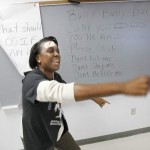 Psychologists find that students who are bullied regularly do substantially worse in school.
Psychologists find that students who are bullied regularly do substantially worse in school.
By Stuart Wolpert, University of California, Los Angeles
Students who are bullied regularly do substantially worse in school, UCLA psychologists report in a special issue of the Journal of Early Adolescence devoted to academic performance and peer relationships.
The UCLA study was conducted with 2,300 students in 11 Los Angeles–area public middle schools and their teachers. Researchers asked the students to rate whether or not they get bullied on a four-point scale and to list which of their fellow students were bullied the most—physically, verbally and as the subject of nasty rumors.
A high level of bullying was consistently associated with lower grades across the three years of middle school. The students who were rated the most-bullied performed substantially worse academically than their peers. Projecting the findings on grade-point average across all three years of middle school, a one-point increase on the four-point bullying scale was associated with a 1.5-point decrease in GPA for one academic subject (e.g., math)—a very large drop.
Teachers provided ratings on how engaged the students were academically, including whether they were participating in class discussions, showing interest in class and completing their homework. The researchers collected data on the students twice a year throughout the three years of middle school and examined the students’ grades.
The study is published Aug. 19 in the journal’s online edition; the print edition will be published at a later date.
“We cannot address low achievement in school while ignoring bullying, because the two are frequently linked,” said Jaana Juvonen, a UCLA professor of psychology and lead author of the study. “Students who are repeatedly bullied receive poorer grades and participate less in class discussions. Some students may get mislabeled as low achievers because they do not want to speak up in class for fear of getting bullied. Teachers can misinterpret their silence, thinking that these students are not motivated to learn.
“Students who get bullied run the risk of not coming to school, not liking school, perceiving school more negatively and now — based on this study—doing less well academically,” said Juvonen, who is also a professor in UCLA’s developmental psychology program. “But the link between bullying and achievement can work both ways. The students who are doing poorly are at higher risk for getting bullied, and any student who gets bullied may become a low achiever. Whether bullying happens on school grounds or after school hours on the Internet, it can paralyze students from concentrating on academics.”
The research is part of a long-term UCLA bullying project led by UCLA education professor Sandra Graham (who is not a co-author on this study) and Juvonen, which is funded federally by the National Science Foundation and privately by the William T. Grant Foundation.
“Instruction cannot be effective unless the students are ready to learn, and that includes not being fearful of raising your hand in class and speaking up,” said Juvonen, who has been studying bullying for more than a decade. “Once students get labeled as ‘dumb,’ they get picked on and perform even worse; there’s a downward cycle that we need to stop.
“If the academically low-performing students are at higher risk for getting bullied, that suggests one way to reduce bullying is to help those students academically,” she added. “Once they get into the cycle of being bullied because of their poor academic performance, their chances of doing better academically are worse.”
Reducing bullying is a “collective challenge,” she said, and not just a matter of dealing with a few aggressive students. The UCLA team’s prior findings show that in middle school, bullies are considered “cool’ by their classmates. The high social status of bullies promotes a “norm of meanness that needs to be addressed.” Bullying affects millions of students, Juvonen said.
Of the students in the study, approximately 44 percent were Latino, 26 percent were African American, 10 percent were Asian American, 10 percent were white and 10 percent were multi-racial. Fifty-four percent were female and 46 percent were male.
 (HealthDay News) — The adolescent victims of cyber bullying report higher levels of depression than do the bullies themselves or bully-victims, but this is not the case with traditional forms of bullying, according to a study published online Sept. 22 in the Journal of Adolescent Health.
(HealthDay News) — The adolescent victims of cyber bullying report higher levels of depression than do the bullies themselves or bully-victims, but this is not the case with traditional forms of bullying, according to a study published online Sept. 22 in the Journal of Adolescent Health.















